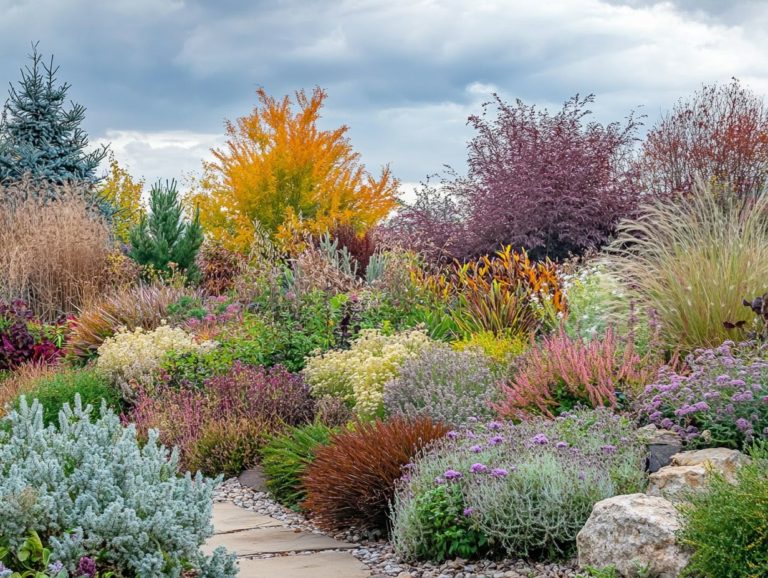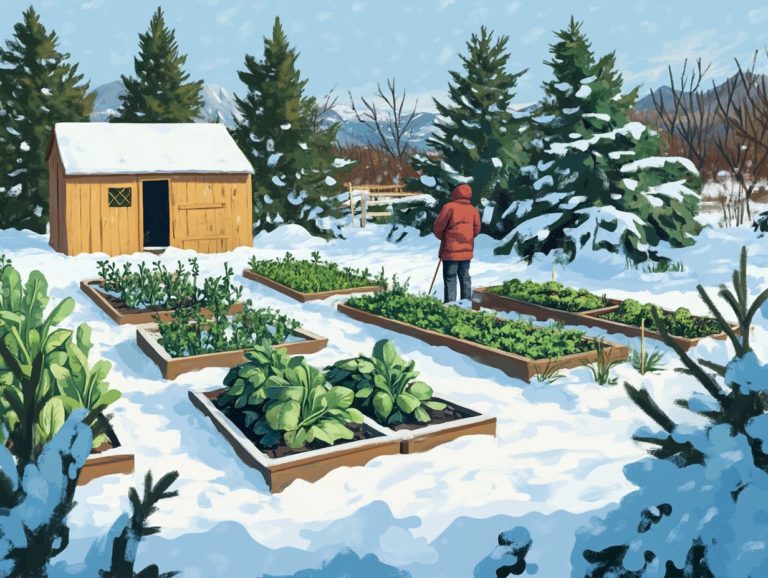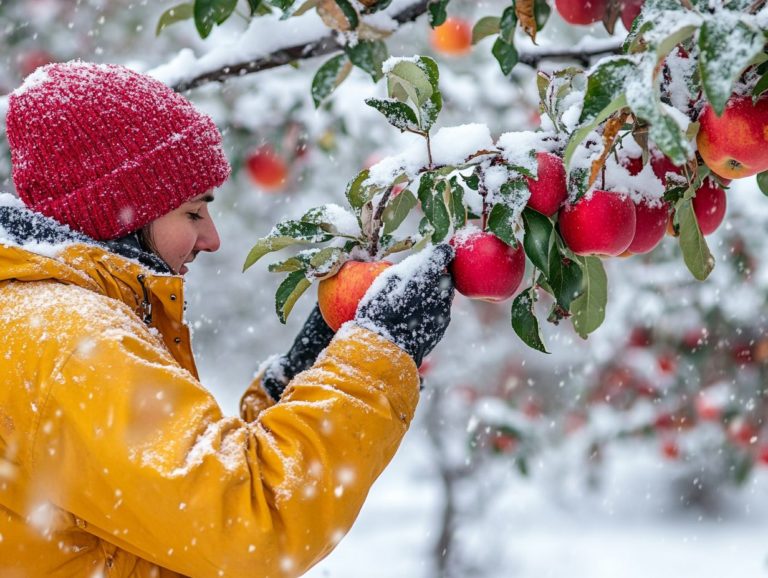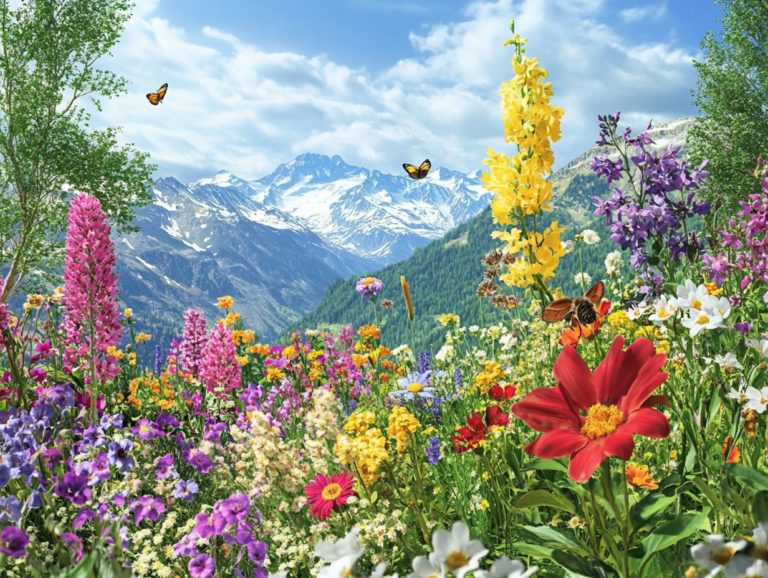Cold-Climate Gardening: Choosing the Right Grasses
Gardening in colder climates offers a distinct set of challenges and opportunities, particularly when it comes to selecting the right grasses.
By making informed choices, you can craft a lush, vibrant landscape that flourishes even in chilly temperatures. This article delves into the advantages of choosing the right grasses, highlighting crucial factors to consider like climate and soil conditions. We ll also explore various grass types that thrive in cold climates and the best practices for planting and maintenance.
Discover the secrets to creating a stunning garden that thrives all year round!
Contents
- Key Takeaways:
- Benefits of Choosing the Right Grasses
- Factors to Consider when Choosing Grasses
- Types of Grasses Suitable for Cold Climates
- Best Practices for Planting and Maintaining Grasses in Cold Climates
- Frequently Asked Questions
- What are some popular grass options for cold-climate gardening?
- What factors should I consider when choosing the right grass for my cold-climate garden?
- Can I use warm-season grasses for cold-climate gardening?
- What are some hardy grass options for extremely cold climates?
- Do I need to consider soil type when choosing grass for cold-climate gardening?
- Is it possible to have a lawn in a cold-climate garden?
Key Takeaways:
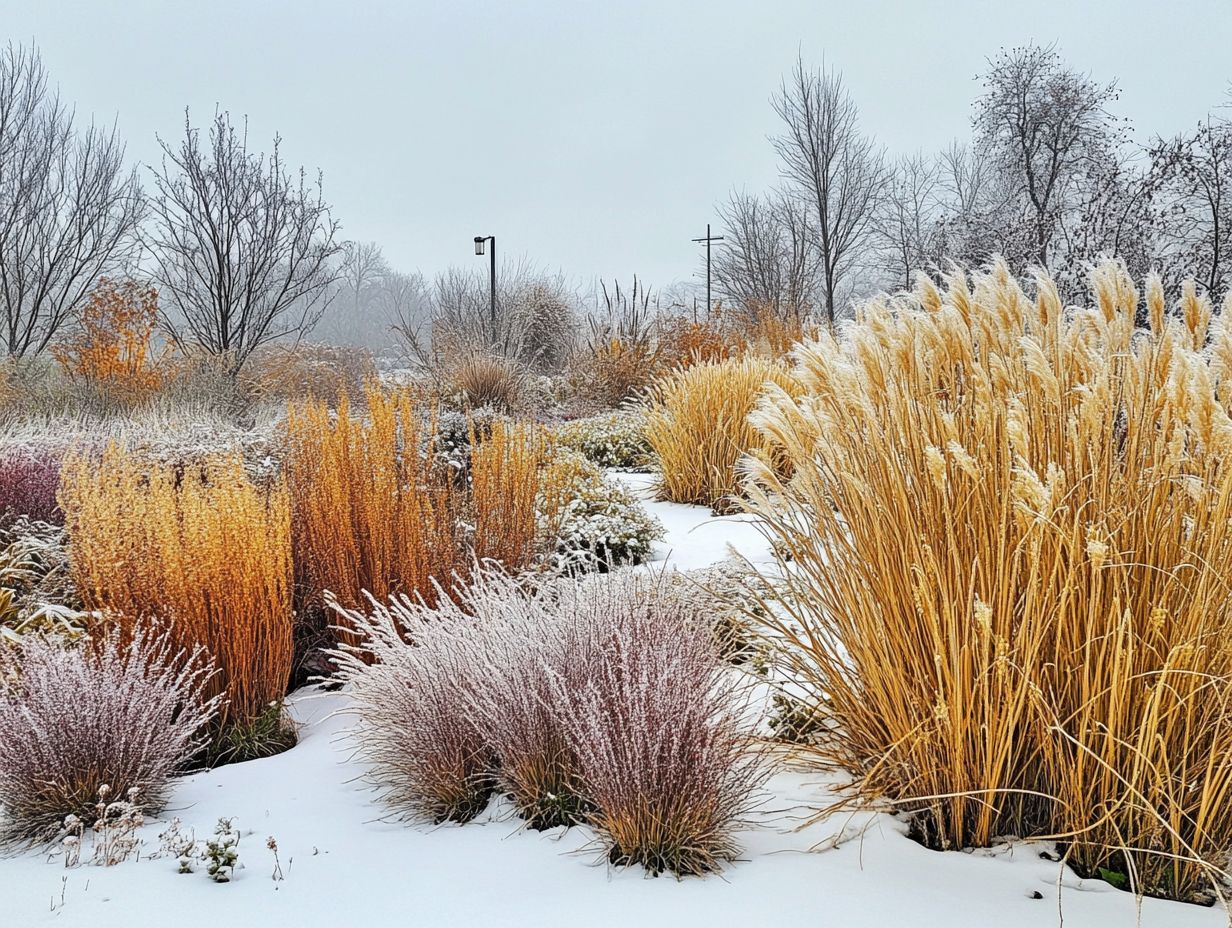
- Choosing the right grasses for cold-climate gardening can improve growth and maintenance, leading to a healthier and more attractive lawn.
- Consider factors such as climate, soil conditions, and desired aesthetics when selecting grass types for your cold-climate garden.
- Cool-season grasses, such as fescue and bluegrass, are ideal for cold climates, while warm-season grasses may struggle. Follow best practices for planting and maintenance to ensure a successful lawn.
What is Cold-Climate Gardening?
Cold-climate gardening is all about nurturing plants and grasses in regions where temperatures tend to stay low, especially during those chilly winter months. This approach is particularly advantageous in cities like Cleveland, OH, Fort Wayne, IN, Indianapolis, IN, Pittsburgh, PA, and St. Louis, MO, where you encounter unique environmental challenges.
By grasping the specific needs of grasses and plants that flourish under these conditions, you can cultivate sustainable and vibrant outdoor spaces that are perfectly suited to the soil type, sunlight exposure, and effective pest management.
In these cooler climates, you ll encounter distinct challenges, such as relentless frost and shorter growing seasons. Thoughtful selection of winter-hardy varieties is essential. By opting for plants that can brave freezing temperatures, you can ensure your garden remains lively even during the harshest winters.
Urban gardening initiatives can embrace eco-friendly practices. Composting and rainwater harvesting enhance soil quality and reduce the need for chemical fertilizers. Prioritizing temperature regulation is vital for successfully establishing grass, creating lush landscapes that beautify urban environments while positively impacting the ecosystem.
Benefits of Choosing the Right Grasses
Choosing the right grasses for your garden is essential to cultivating a thriving landscape that offers numerous benefits, including improved disease resistance and easier lawn renovation, not only for the environment but also for your maintenance routine. By selecting suitable grass species like Kentucky bluegrass, tall fescue, fine fescue, and perennial ryegrass, you can enhance both the aesthetics and functionality of your lawn.
This thoughtful selection fosters biodiversity and plays a vital role in noise reduction and temperature regulation, particularly in urban settings.
Improved Growth and Maintenance
Improved growth and maintenance of grass species significantly influence the longevity and health of your lawn, particularly in cold climates. Challenges like foot traffic and frigid temperatures can impede development, making professional guidance beneficial for optimal results. Understanding best practices in lawn care such as proper seedbed preparation, effective watering techniques, and thoughtful grass mixtures is essential for achieving successful grass establishment.
By adopting advanced growth techniques, you can ensure your lawn thrives with minimal intervention. A well-planned watering routine, ideally scheduled for early morning or late afternoon, promotes deeper root systems, allowing your grass to withstand harsh conditions more effectively.
Regular fertilization and selecting hybrid grass varieties enhance resilience to diseases and improve stress tolerance, ensuring a robust lawn throughout the year while addressing common issues like weed control. Incorporating compost enriches your soil with vital nutrients, and implementing effective drainage solutions prevents waterlogging, creating an optimal environment for grass growth and reducing maintenance efforts over time.
Start your gardening journey today and transform your outdoor space into a thriving oasis!
Factors to Consider when Choosing Grasses
When selecting grasses for cold-climate gardening, it’s essential to consider several critical factors for optimal growth and sustainability, including selecting cold-climate plants for urban gardens.
Begin by understanding your specific soil type and its drainage capabilities. Assess sunlight exposure throughout the day.
Consider how cold temperatures and foot traffic may affect the grass species you choose. If you’re gardening in urban environments like Indianapolis, IN, or St. Louis, MO, pay special attention to shade tolerance and the unique microclimates that may exist in your space.
Climate and Soil Conditions

Understanding climate and soil conditions is key to establishing a thriving lawn in cold climates.
Soil type and drainage directly influence nutrient retention and the vitality of your grass. Local climate variations determine which grass species thrive in areas like Fort Wayne, IN, or Cleveland, OH.
Conducting proper soil testing, including pH measurements and nutrient analysis, will give you valuable insights into your grass’s specific needs. Using methods such as amending the soil with organic matter or utilizing aeration which means creating holes in the soil to allow air, water, and nutrients to reach the grass roots can significantly boost nutrient availability and enhance drainage.
For example, you might consider adding compost or gypsum to improve the texture and permeability of your soil. Choosing the right grass varieties can help you create a beautiful, thriving lawn, especially in areas where winter dormancy comes into play.
Desired Aesthetic and Functionality
The aesthetic and functionality of your lawn are crucial in determining which grass species to select. In urban areas like Pittsburgh and Indianapolis, balance stunning ornamental grasses with practical lawn varieties that can endure foot traffic, incorporating functional elements that offer environmental benefits like noise reduction and temperature regulation.
By thoughtfully blending ornamental grasses with traditional turf varieties, you can craft a vibrant landscape that not only delights the eye but also serves multiple functional purposes. Selecting the right mixtures requires you to consider factors such as climate, sunlight exposure, and soil quality to ensure compatibility and longevity.
Incorporating a diverse range of grass types can foster healthier ecosystems, enhance biodiversity, and attract beneficial insects, significantly improving your ecological impact. This careful selection enhances your lawn’s resilience, transforming it into a valuable asset in any urban environment, offering both aesthetic pleasure and practical performance.
Types of Grasses Suitable for Cold Climates
Selecting the ideal grasses for cold climates is crucial for cultivating resilient and vibrant landscapes. For a deeper insight, understanding plant selection for cold-climate design can help you choose the right varieties. Cool-season grasses such as Kentucky bluegrass, tall fescue, fine fescue, and perennial ryegrass flourish during the cooler spring and fall months.
These varieties not only provide exceptional growth but also adapt beautifully to regions with cold temperatures. While warm-season grasses may not be the primary choice, they can still enhance specific areas of your garden, creating a dynamic and appealing environment.
Act now to transform your landscape!
Cool-Season Grasses
Cool-season grasses, like Kentucky bluegrass, tall fescue, fine fescue, and perennial ryegrass, are ideal for cold-climate gardening. They thrive in cooler temperatures and adapt well to various soil types. These grasses hit their growth stride in spring and fall, making them perfect for areas with distinct temperature swings.
Kentucky bluegrass stands out with its vibrant color and lush density. However, it requires regular watering and occasional fertilization to maintain its appearance. In contrast, tall fescue has impressive drought tolerance and a coarser texture, meaning you can expect less frequent mowing.
If you re after a delicate touch, fine fescue varieties are perfect; they tolerate shade well, making them suitable for planting under trees or in cooler, shaded spots, though they have specific soil needs. For a quick fix, perennial ryegrass germinates rapidly, making it an excellent option for speedy patches.
To integrate these grasses into your lawn care routine, consider these advanced growth techniques:
- Alternating seeding methods, including the use of hybrid grasses
- Balancing appropriate watering schedules, especially with seasonal changes
- Monitoring for common diseases and implementing effective pest management strategies
Following these steps will help you cultivate robust, healthy lawns in cold climates.
Warm-Season Grasses
While cool-season grasses are often the first choice for cold-climate gardening, understanding warm-season grasses can elevate your lawn to new heights. These grasses flourish in summer, adeptly adapting to warmer conditions, and can be strategically placed in areas where the heat reigns supreme.
Consider varieties like Bermuda, Zoysia, and Buffalograss; these thrive in transitional zones or microclimates, adding not only visual appeal but also resilience to your landscape. When paired with cool-season varieties, they promote biodiversity, fostering habitats for beneficial insects and microorganisms that contribute to a healthier lawn overall.
Warm-season grasses come with their own maintenance needs. They may require more frequent mowing and specific watering schedules during scorching months. Embracing these nuances can lead to a robust and vibrant lawn that thrives throughout the year.
Best Practices for Planting and Maintaining Grasses in Cold Climates
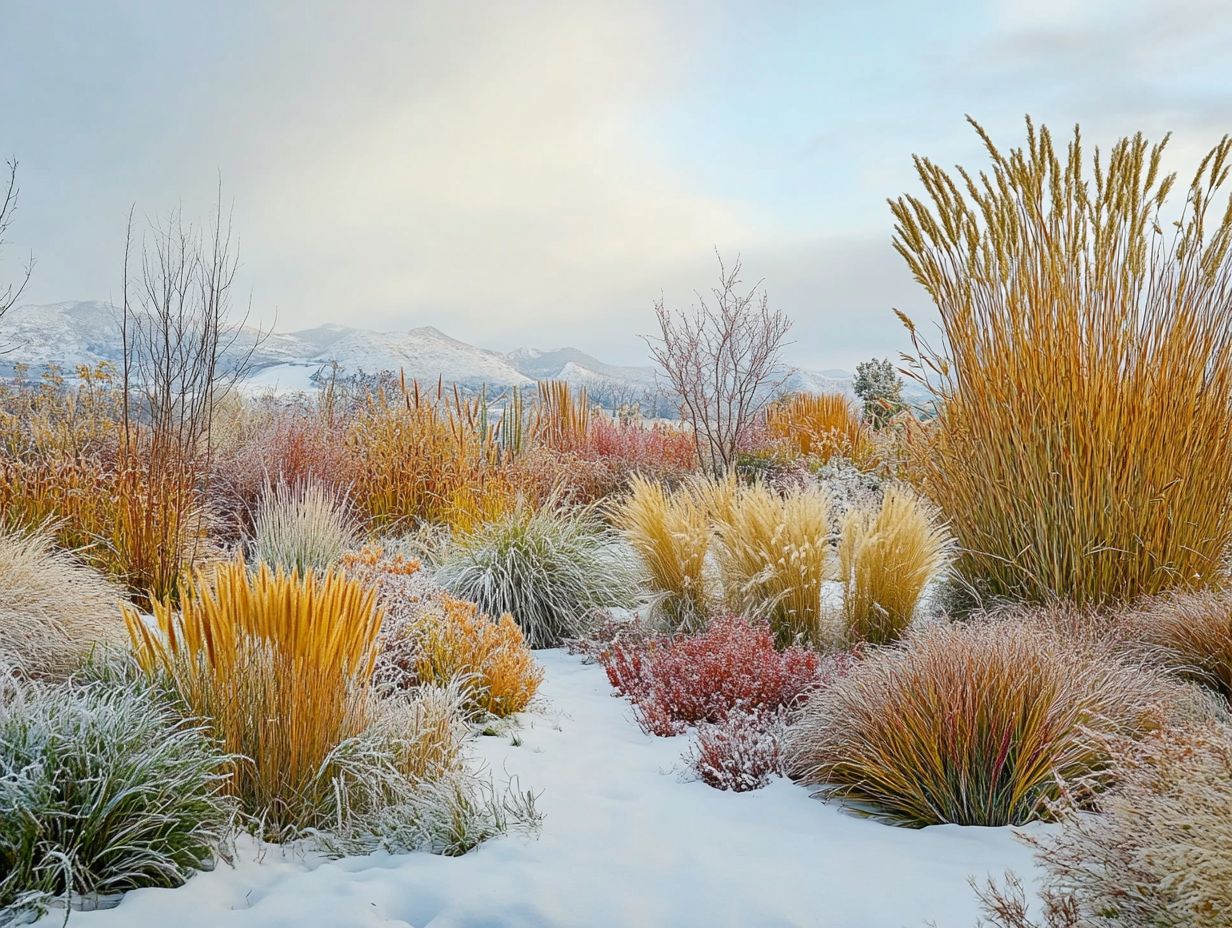
Act now! Implement best practices for planting and maintaining grasses in cold climates to ensure your lawn s long-term health and resilience. This involves meticulous seedbed preparation, effective watering techniques, and timely lawn renovations.
Each of these elements plays a vital role in establishing a robust grass that can endure frigid temperatures and withstand foot traffic. This ultimately leads to a thriving outdoor space.
Preparation and Planting Techniques
Preparation and planting techniques are crucial for establishing a thriving lawn in cold climates. Your attention to soil conditions and timing makes a significant difference in achieving optimal growth. Proper seedbed preparation is key. Ensuring adequate drainage, nutrient levels, and soil aeration will promote healthy root development and enhance the overall vitality of your lawn.
For best results, stick to specific seeding rates tailored to the cool-season grasses you ve chosen, typically sowing between 3 to 5 pounds of seed for every 1,000 square feet. Timing is everything; aim to plant in early spring or early fall, when temperatures are cooler and moisture levels are generally higher. Employ strategies for soil moisture retention, such as using mulch or organic matter, to boost growth further.
Mixing species like Kentucky bluegrass and fescue increases resilience against pests and diseases. It also adds visual variety to your landscape.
This thoughtful approach can transform an ordinary yard into a lush, inviting oasis.
Proper Maintenance and Care
With proper maintenance, your lawn can be a stunning oasis! Keeping your grass healthy in cold climates allows it to thrive even in the harshest conditions. Key maintenance requirements include suitable watering techniques, regular mowing, fertilization, and effective pest management. These all play a vital role in the overall health and appearance of your lawn.
It’s important to recognize that different grass species, like Kentucky bluegrass and tall fescue, have unique needs that require a customized approach for optimal growth. Tailoring your maintenance strategies to suit these varieties not only enhances their resilience and aesthetic appeal but also significantly impacts soil health.
You can promote sustainability by incorporating eco-friendly practices, such as composting and using organic fertilizers. This helps create a balanced ecosystem in your lawn.
By prioritizing these strategies, you can cultivate a thriving green space that is both visually stunning and environmentally responsible. What will your dream lawn look like?
Frequently Asked Questions
What are some popular grass options for cold-climate gardening?
Some popular grasses for cold-climate gardening include fescue, bluegrass, and ryegrass.
What factors should I consider when choosing the right grass for my cold-climate garden?
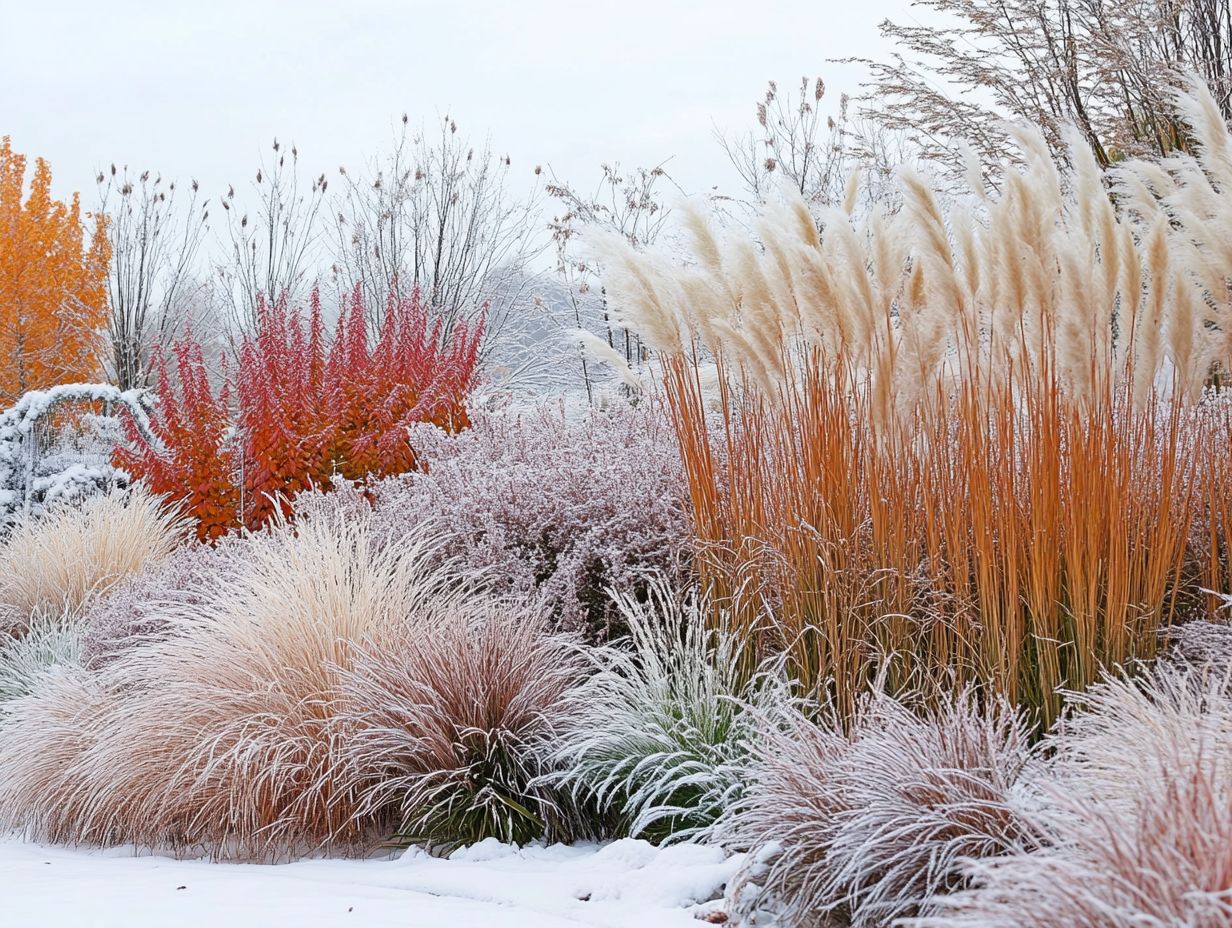
When choosing the right grass for cold-climate gardening, consider factors such as hardiness, disease resistance, and selecting plants for cold-climate rain gardens to ensure optimal growth and sustainability.
Can I use warm-season grasses for cold-climate gardening?
No, warm-season grasses are not suitable for cold climates as they cannot survive the harsh winter temperatures.
What are some hardy grass options for extremely cold climates?
Some hardy grasses that can withstand extremely cold climates include creeping bentgrass, red fescue, and Kentucky bluegrass.
Do I need to consider soil type when choosing grass for cold-climate gardening?
Yes, it is important to consider soil type when choosing grass for cold-climate gardening, as certain grasses may thrive better in acidic or alkaline soils.
Is it possible to have a lawn in a cold-climate garden?
Yes! With the right grass selection and proper care, you can have a lush and healthy lawn in a cold-climate garden.

